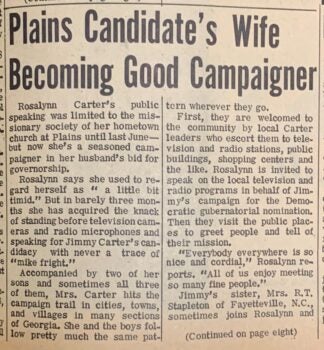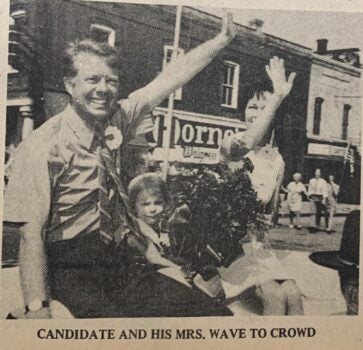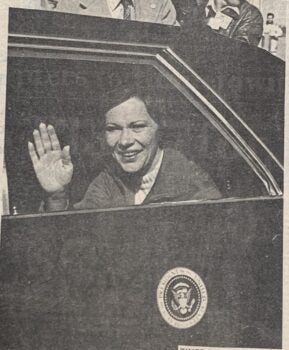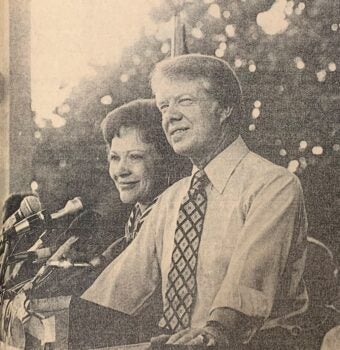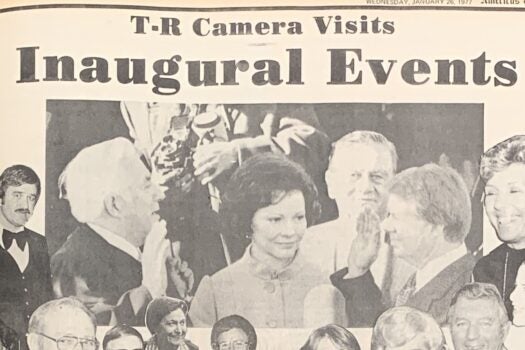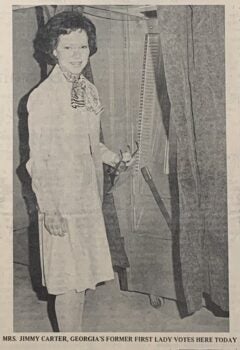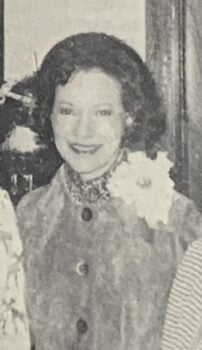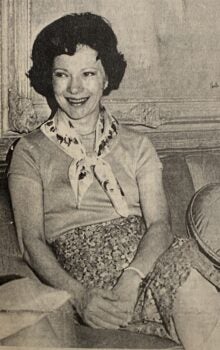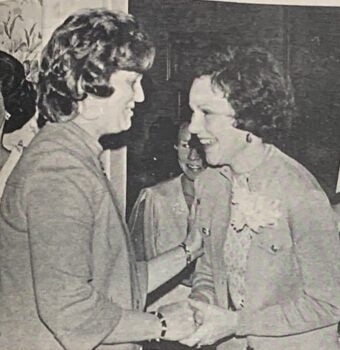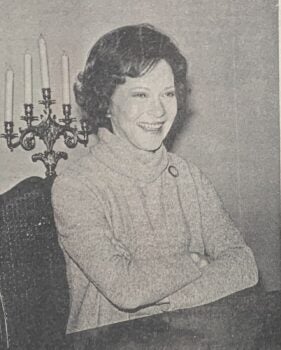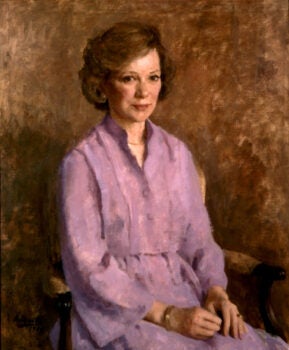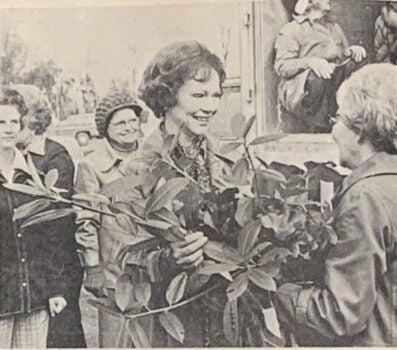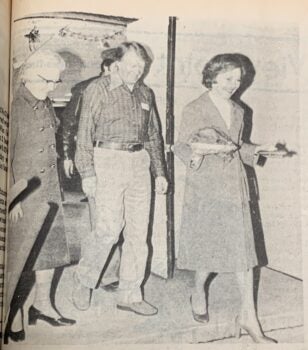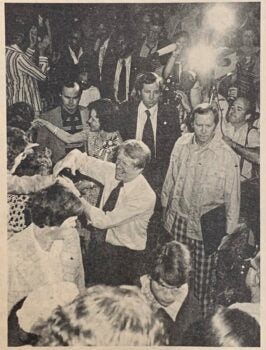Rosalynn Carter: A First Lady on the Move
Published 10:58 am Tuesday, November 21, 2023
|
Getting your Trinity Audio player ready...
|
By D. Jason Berggren, Professor of Political Science at Georgia Southwestern State University, His wife, Bonnie K. Levine-Berggren, assisted with the proofreading.
Rosalynn Carter, the former first lady of the United States and first lady of Georgia, died peacefully on November 19, 2023, at her home in Plains. She was 96.
Two days earlier, the Carter Center announced that Mrs. Carter entered hospice care. Back in May, it was announced that she had dementia.
Jimmy Carter, her husband of 77 years, said, “Rosalynn was my equal partner in everything I ever accomplished. She gave me wise guidance and encouragement when I needed it. As long as Rosalynn was in the world, I always knew somebody loved and supported me.”
Mrs. Carter will be buried in Plains near her Woodland Drive home. Various funerary events will be held the week of November 27 in Plains, Americus, and Atlanta.
As part of the Americus Times-Recorder’s tribute to Rosalynn Carter, this article and the accompanying images are dedicated to her memory, her life, and her public career. These were the prepared remarks I delivered for presentation at the September 2023 monthly meeting of the Daughters of the American Revolution, Americus, Georgia. For the occasion, I was asked to do a twenty-minute presentation on Mrs. Carter and I chose to focus on her role as a political campaigner. For a generation (1961-1981), she practiced the art of electoral politics at the local level, the state level, and the national level. Her first experience was a school consolidation referendum in 1961 and her last involving her husband was the 1980 re-election run. This experience served her well as she later joined her husband in monitoring elections around the world. For several decades she did this work with the Carter Center to promote and consolidate democracy.
Rest in peace and farewell, Mrs. Carter, and may her memory be a blessing.
Here were my remarks on September 12, 2023. Some images referenced are in the PowerPoint presentation but may not appear here in print or online.
Good morning, everyone. Thank you for having me today.
I’m truly honored to be here to make a few observations about a remarkable person who lives and was born and raised right here in Sumter County, Mrs. Eleanor Rosalynn Smith Carter. I’m sure many of us here have at the very least seen her in person, perhaps met her, and have had some interactions with her. Perhaps some of you, maybe more, know her well and have many stories to tell about the kind of person she is and has been through the years.
As we know, Mrs. Carter recently celebrated her 96th birthday. What a blessing. So, from her timeline, from her resume, what does one highlight? What are some key things we can take and appreciate from her life? This is the challenge I think for any presenter.
In 1999, President and Mrs. Carter each received the Presidential Medal of Freedom, the highest civilian award in the United States. They were given the award by President Bill Clinton.
This is what President Clinton said during his remarks at the award ceremony in Atlanta. “In the past, this award has been presented to people who have helped America promote freedom by fighting for human rights or righting social wrongs or empowering others to achieve or extending peace around the world. But rarely do we honor two people who have devoted themselves so effectively to advancing freedom in all those ways. Jimmy and Rosalynn Carter have done more good things for more people in more places than any other couple on the face of the earth.”
This then is the challenge of what to emphasize. President Clinton highlighted Mrs. Carter’s contributions on mental health and vaccine immunizations for children. He joked that “every time she showed up, the kids would cry, because they knew somebody was going to get a shot.”
As a professor of political science, I’m naturally preoccupied with politics, with political phenomena, and how individuals function as political actors. Thus, that is the angle I take on Mrs. Carter. My presentation today is a tribute to her in that light and I contend that in her role as the first lady of Georgia and first lady of the United States she was a political innovator and she was always on the move.
Mrs. Carter was determined to be an active first lady. Indeed, one Spanish publication described her as “muy activa.”
Historically, the first lady has played a very traditional, mostly behind-the-scenes role. First and foremost, the first lady was expected to perform the duties of wife, mother, and grandmother. These responsibilities mirrored those of women generally in the country.
Mrs. Carter performed this role, too, as has her first lady contemporaries had done and continue to do.
The images here show Mrs. Carter with her husband, her four children, some of her grandchildren, her daughters-in-law, her mother, Mrs. Allie Murray Smith, and her mother-in-law, Miss Lillian Gordy Carter.
Like other first ladies, Mrs. Carter also performed the role of White House hostess, decorator, and entertainer. She regularly greeted visitors to the White House, including the leaders of foreign countries and their spouses. She helped to plan and organize state dinners. Mrs. Carter provided her input on White House decorations and décor and White House events and entertainment.
However, Mrs. Carter did not confine herself to the traditional roles and expectations. She helped to modernize the image of the First Lady.
Mrs. Carter was truly the President’s partner and one of his key political advisors and defenders. She was there at his side during his presidency and throughout his political career. She has been there for more than 77 years of marriage.
The images here capture her essentialness. She made the front cover of Newsweek in November 1979. The other image shows her in the East Wing of the White House and busy at work as she creates the very first Office of the First Lady.
Although the office is not mentioned in the Constitution, it is now viewed as an indispensable part of the modern presidency. Arguably, it is fair to conclude that this role, in terms of politics, in terms of advancing the president’s agenda, in terms of protecting the president’s image, is now a top-tier White House and administration position. Rosalynn Carter was a major contributor to this development. She was part of the inner circle, attended cabinet meetings, and had both access and influence.
Rosalynn Carter contributed to this modern development in being first lady in a major way. She engaged several domestic policy issues. For example, she was a strong advocate for women’s rights. She actively campaigned for the ratification of the Equal Rights Amendment which aimed to prohibit federal and state discrimination based on gender.
Congress first approved the measure in 1972 and then sent it to the states to be ratified. President Carter approved a congressional resolution to extend the time for state consideration from 1979 to 1982. Mrs. Carter attended the signing ceremony. Ultimately, however, the effort fell short.
Mental health was another issue Mrs. Carter championed. This was something she had previously prioritized while the first lady of Georgia.
The images here show her leadership on the issue. She was named the honorary chair of the President’s Commission on Mental Health in 1977. In this role, she toured the country to highlight the issue and held hearings to discuss what policies could be adopted.
In a historic moment in the history of first ladies. In February 1979, she testified before Congress on mental health policy. After Eleanor Roosevelt in 1945, Mrs. Carter was the second first lady to do this. Hillary Clinton would be the third.
First Lady Carter was also involved with foreign policy. Her 1977 goodwill trip to Latin America and the Caribbean is illustrative. Over two weeks, she visited seven countries – Jamaica, Costa Rica, Ecuador, Peru, Brazil, Colombia, and Venezuela.
But this was more than a trip of symbol and gesture. In terms of U.S. foreign policy, President Carter prioritized better relations with Latin America. He sent Mrs. Carter to the region to emphasize how serious he was about this.
Since presidents can’t be everywhere at once, they often send surrogates to represent them. For the time, it was unusual to send the first lady on a mission such as this. This trip occurred during a time when negotiations on the Panama Canal were ongoing.
In the twentieth century, presidential candidates campaigned more directly and openly for the office. This has been especially true since the 1972 nomination process reforms. Now, candidates not only actively run for office in the general election they run early and run hard in the primaries. In this, the first lady is also crucial to election and re-election.
Mrs. Carter ably performed this role as well. The images here show Mrs. Carter in this very modern capacity – visible and supportive. She often made joint appearances with Mr. Carter, appearing behind him or at his side. These select images from 1976 illustrate that.
Like the candidates themselves, the first ladies and candidate spouses also embody and reflect the spirit of this democratic republic. They give life to our campaigns. They are not spectators or bystanders, but active participants and agents in our democracy. The national media took note of Mrs. Carter’s presence and impact.
These images show Mrs. Carter by Jimmy Carter’s side at the end of the 1976 primary season. Her husband earned the most votes and was projected to possess a majority of the delegates needed to win the Democratic Party nomination. In June, Carter was the presumptive nominee.
The images here are from the Americus Times-Recorder. This image is of the Carters in Plains after Jimmy accepted the 1976 Democratic Party’s presidential nomination in New York City. It was always a team effort.
However, a team effort does not necessarily mean that they were always campaigning together. Indeed, to make the most out of retail, grassroots, person-to-person politics, they often campaigned separately.
Though she would say that she was initially timid and hesitant, Mrs. Carter soon excelled at campaigning and became an indispensable part of the Carter electoral effort. She actually came to enjoy hitting the campaign trail.
Campaigning, Mrs. Carter was a “happy warrior”. She enjoyed meeting people, answering questions, and studying the issues. Yet, it was demanding physically and mentally.
Initially, the crowds were small. She said early on, “There were coffees and teas and receptions, luncheons and dinners in private homes, more often than not with only a handful of people—ten or twelve was a crowd.” She liked the intimacy and the ability to connect.
After each trip, Mrs. Carter would return home and tell her husband about her experiences.
In time, the crowds would grow and the press coverage more intense.
For the 1976 presidential campaign, Mrs. Carter often campaigned independently of her husband. In her book, First Lady from Plains, this is what she wrote: “For the next eighteen months we were on the go constantly. I stayed home for one week and was off again, this time to Iowa. From Iowa it was back to Florida, then to New Hampshire, to Iowa again, and back to Florida. I traveled and traveled and traveled in that campaign. At first I was gone three days, then four, and then five days a week. Before it was over, I had spent seventy-five days in Florida alone. Tim Kraft, a campaign coordinator, said I had covered 105 communities in Iowa alone. And though I didn’t count, I spend days and days on end, weeks and weeks, in New Hampshire and Maine, with side trips into Vermont and Massachusetts. I campaigned in Pennsylvania, Ohio, Illinois, Wisconsin, Mississippi; at the end I had been in forty-two states in our country.”
The fall campaign was similar. She campaigned with her husband at times, but the rest of the time she was on her own. After the fall campaign kickoff in Warm Springs, Ga., the Americus Times-Recorder reported that Mrs. Carter headed for campaign stops in 5 states and 14 cities.
Florida was one of those stops. With Governor Reubin Askew by her side, she campaigned in Tallahassee and spoke from the steps of the State Capitol.
When she was not actively campaigning in the summer, she said that she was still quite busy with “studying the issues, writing letters, and working on speeches for the fall campaign.”
Mrs. Carter liked to begin her remarks with “I’m Mrs. Jimmy Carter. My husband’s running for President.”
In 1976, Mrs. Carter overcame her shyness and fears of public speaking. In 1978, she was back on the campaign trail and venturing out by herself. Again, she made speeches before large crowds, talked to small groups, did interviews with the press, and met with the voters during the midterm year. She once more proved to be an effective, retail-style campaigner.
What makes the 1978 election significant is that Mrs. Carter was not campaigning for her husband, but for other Democratic candidates. She had become a party leader in her own right, and an in-demand campaign spokesperson. She campaigned for congressional and gubernatorial candidates. These images are from Florida as she campaigned for Bob Graham for Governor.
For most of the 1980 election, it was Mrs. Carter who did the heavy campaigning and not the President. With the Iranian hostage crisis, Soviet invasion of Afghanistan, and plans to boycott the Summer Olympics in Moscow, it was thought best for Carter to run a “Rose Garden” strategy from the White House, stay focused on being president, and let Mrs. Carter and Vice President Walter Mondale do the campaigning and responding to the attacks coming from the challenger, Senator Edward Kennedy.
She campaigned hard and vigorously defended her husband and his record. Kennedy and the press frustrated her with their sharp attacks on Carter’s leadership.
Mrs. Carter campaigned hard in the fall, too. Here’s an example from September 1980. This article covered her campaign swing through Alabama. The Deep South was once again key for Carter’s election strategy. Mrs. Carter was there to shore up support.
Mrs. Carter’s activities included delivering remarks before the Woman’s Auxiliary of the National Baptist Convention in Birmingham, with about 5,000 in attendance, holding a press conference, and opening a Carter-Mondale campaign headquarters in the state.
Mrs. Carter loved election campaigns and the thrill of competition. She liked being a “political wife.” But, in fact, she said, she was more a “political partner.”
She played an active and visible role not just in Mr. Carter’s two presidential runs, but also his runs for the Georgia State Senate in 1962 and for Governor in 1966 and 1970.
In fact, her first electoral effort was in 1961 when Mr. Carter led a referendum campaign to consolidate the county and city public schools in Sumter County into one countywide district. She said, “It was our first venture into politics.” Although the measure narrowly went down to defeat, she “made telephone calls, wrote letters, and raised money for newspaper and radio advertisements.”
The Americus Times-Recorder printed an article in August 1966 with headline, “Plains Candidate’s Wife Becoming Good Campaigner.” The article noted that “she’s a seasoned campaigner in her husband’s bid for governorship.” It also stated, “[I]n barely three months [Mrs. Carter] has acquired the knack of standing before television cameras and radio microphones and speaking for Jimmy Carter’s candidacy…Mrs. Carter hits the campaign trail in cities, towns, and villages in many sections of Georgia.”
At the end of her 1984 memoir, she wrote, “I miss the world of politics. Nothing is more thrilling than the urgency of a campaign – planning, the strategy sessions, getting out among people you’d never otherwise meet – and the tremendous energy it takes that makes a victory ever so sweet and a loss so devastating.” And she made clear “I don’t like to lose.” If her husband had decided to run for office again, she made it clear that she would have been at his side and “out there campaigning right now.”
This, I think, is an important, yet underappreciated part of her legacy – Mrs. Rosalynn Carter, first lady of the United States and first lady of Georgia was an active, skillful participant in our democratic elections, a “steel magnolia”. She was a hands-on practitioner of democracy for a generation (1961-1981), and because of this, after the Carter presidency, she joined her husband as a credible and powerful advocate for monitoring elections and promoting and securing democracy around the globe.
When asked by Leila Case Barrett of the Americus Times-Recorder in January 1977 what kind of first lady she’ll be, she said, “I’ll just be me—Rosalynn.” She certainly did that.
We proudly acknowledge Mrs. Carter and thank her for her tremendous service and her commitment to serve. Thank you for listening.


